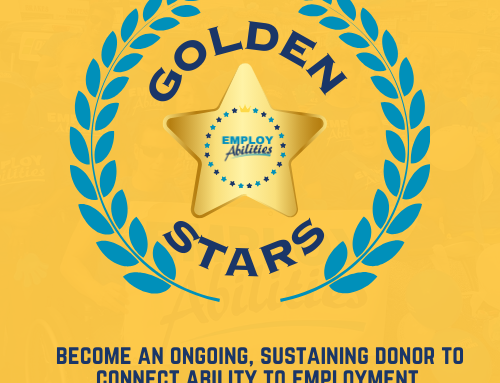
May the Fourth has become something of a big deal in today’s culture. On or around the fourth of May, you’ll probably be hearing “May the fourth be with you” everywhere—on social media, from friends, and maybe even from people you might not expect. The phrase itself is a take-off of “May the force be with you” from the Star Wars films. Appropriately, May 4 is now Star Wars Day, with a myriad of celebrations, both official and unofficial.
It got us thinking – how is disability presented in the Star Wars universe? And what, if anything, does that tell us about how disabilities are perceived in the general population?
What can we learn from fiction?
Before we begin, it’s important to note a couple of things. First, Star Wars is a work of fiction, and is famously set “a long time ago in a galaxy far, far away”. As such, drawing firm conclusions about disability (or anything else) relating to the here and now is a bit risky. Second, the first movies in the series came out in the late 1970s and early 1980s, when attitudes towards disability were different than they are today. Because of this fact, however, it can be interesting to explore how attitudes toward disability have evolved over time as compared to the more recent films.
Darth Vador
The most famous example of disability in the Star Wars universe is probably Darth Vader – the main antagonist of the first three films (or Episodes IV through VI, if you prefer.) Anakin Skywalker, aka. Darth Vader is a quadruple amputee and burn survivor. As various authors have noted, Vader’s disability is presented in a way that deprives him of his humanity – he’s “more machine than man”. As a cyborg, some have even questioned if Darth Vader even qualifies as disabled at all. When it comes down to it, though, despite his powers and reconstructed body, he’s a flesh-and-blood human being who is reliant on his suit to live. Darth Vader’s disability – exemplified by his heavy breathing – is constantly on display.
Yoda & Luke Skywalker
Another example of disability in the Star Wars universe is Yoda, who walks with a cane. In the Star Wars universe, Yoda is a sympathetic character – an ally of the good guys – who has a deep connection to the force. Besides the iconic sage advice he memorably dispenses, Yoda has shown himself to be a capable fighter, capable of quick bursts of energy when required. His disability is not presented as a great burden or impairment – it simply is. Unlike Darth Vader, Yoda’s disability doesn’t deprive him of his humanity or make him morally suspect.
Likewise, Luke Skywalker – who has his arm cut off at the end of The Empire Strikes Back – is quickly fitted with a prosthetic limb, and it’s never mentioned again. In both the instances of Yoda and Luke, disability is normalized.
Chirrut Imwe
Moving into the twenty-first century, we have Chirrut Imwe, the blind warrior-monk who first appeared in Rogue One. While his blindness contributes to a number of humorous interactions and scenes (which is arguably problematic), Chirrut Imwe is ultimately uninhibited by his disability. In fact, at the conclusion of the film, he is able to miraculously achieve a feat that turns the tides of the battle. In Rogue One, Chirrut Imwe is presented as something extraordinary – a kind of “supercrip.” As noted by disability scholars, “By focusing on individual achievements, either mundane tasks or extreme feats such as climbing a mountain, the supercrip implies that effort and willpower of the individual are all that is needed for people with disabilities to overcome obstacles in life.”
What about invisible disabilities?
The above examples all refer to visible physical disabilities. But we know many disabilities are invisible. Do characters in the Star Wars universe have invisible disabilities – like mental health challenges – and how is this handled in the films? Short answer? Yes.
Bodhi Rook
As Ada Hoffman writes:
“The least ambiguous depiction of mental illness in Star Wars is a sympathetic one – Rogue One’s Bodhi Rook. Rook encounters a telepathic tentacle creature called a Bor Gullet which, he’s warned, can cause victims to lose their minds. Afterwards, he experiences catatonia and depersonalization and has to be reminded who he is. Rook consistently appears anxious, before and after this incident: wide-eyed, twitchy, stammering. It’s not clear how much of this is an after-effect of the Bor Gullet, how much is an anxiety disorder Rook may have already had, and how much is a normal reaction to how stressful his life has become. Either way, Rook struggles with anxiety while remaining a sympathetic character capable of great courage and cleverness.
Saw Gerra
In addition to Bodhi Rook, we have Saw Gerrera, the battle-hardened freedom fighter from Rouge One. Throughout the film, he seems to be experiencing mental health issues related to his unfounded fears of betrayal. This could be the manifestation of any number of diagnoses, including post-traumatic stress disorder, borderline personality disorder, and schizophrenia. The issues are never framed as mental health challenges, nor is Saw given any help to alleviate these issues.
C3PO and R2D2
Also, much earlier in the franchise (in the first film), we were introduced to CP30, the humanoid robot, and R2-D2, the lovable droid. Capable of exhibiting human emotion, the two characters are often played for laughs. Many have speculated, however, that both characters have anxiety issues, which is no laughing matter for those who deal with these issues in real life.
May the fourth be with you
So, in summary, in the Star Wars universe – like in our own – there exist people with disabilities. And in both worlds, there are positive, affirming depictions of disability and problematic characterizations that present people with disabilities as threatening and sub-human. In the end, as said by Elisa Shaholli, “[The Star Wars films] can act as a larger metaphor for films with disabilities today: taking steps when it comes to the improvement of disability representations, yet still behaving as perpetrators of long-held stereotypes and archetypes.”
May the Fourth Be With You!





